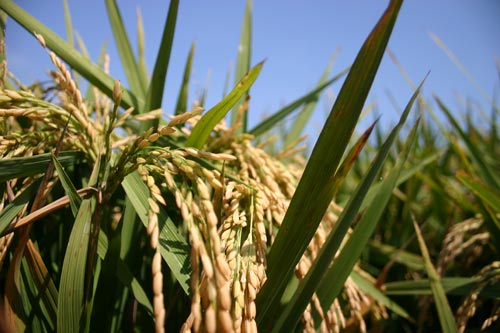July 12, 2011

We have been reporting for a couple of weeks about the higher than average numbers of rice stink bugs, even in fields that were not heading. Now as the majority of the crop started heading last week and this week, the number of rice stink bugs in fields appears to be blowing up. We initiated a test last week in Lonoke Co. on rice that was starting to head and estimated the population at about 15 stink bugs per 10 sweeps. At 3 days after treatment, the untreated checks were running in excess of 100 stink bugs on 10 sweeps. In fact, many of the untreated checks were running over 200 stink bugs per 10 sweeps! Obviously, that’s a big jump in just a few days and indicates the mobility of the stink bugs and how fast the numbers can get out of hand. Even in our treatments in most cases, the numbers were still 20-30 rice stink bugs per 10 sweeps. With a threshold of 5 per 10 sweeps (the first two weeks of heading), you can see we were still well above threshold only 3 days after application. This isn’t due to a lack of control but more of a situation of overwhelming numbers moving into the field.
In situations like the one described above, none of our treatments reduced stink bugs below treatment level. If you think about it, 90% control of 200 stink bugs still leaves 20 stink bugs per 10 sweeps. This means that a second treatment may be required 5-7 days later to achieve control below threshold numbers. Scouting the field 4-5 days after application is the only way to determine if a second treatment is necessary.
We encourage you to wait until at least 50-75% heading to make the first application. Based on the massive movement we saw in our plots, if you spray before heading, you will likely end up having to treat again at 50-75% heading and then again 5-7 days later. Stink bugs are very mobile and can move distances of greater than a mile in just a day or two. They are strongly attracted to fields as they begin to head, so premature spraying won’t do you any good in my opinion. It will only cost you an additional money. I don’t think all fields will reach infestations like the one I described above, however, based on my observations and those folks that I’ve talked to; the numbers in many fields are high to very high. I don’t think all fields are in this situation, and we certainly don’t advocate just spraying without looking. Get out there and scout your fields and spray as needed. Products labeled for control include: Declare, Karate Z, Mustang Max, Methyl Parathion and Sevin XLR or 4E. All of these products provide fairly quick knockdown and should reduce populations, in most cases, below threshold; however, in situations like our trial, two applications may be required. Do some price shopping and get the best product for the price.
Previous studies tell us that infestation levels like we are experiencing in our trial field can reduce yields 30 bushels per acre or even more. During the first two weeks of heading, controlling rice stink bugs will maintain yield. In the second two weeks, we treat to avoid “pecky” rice discounts. Remember, we drop our threshold to one per sweep or 10 stink bugs per 10 sweeps in the third and fourth week of heading. It is my understanding that several of the rice buyers have tightened down on peck, so it is very important to keep rice stink bugs below threshold levels in the crop, to maintain yields and avoid harsh discounts.
So get out there and scout, watch for developing populations, and if and when thresholds are reached, take action accordingly.
You May Also Like




